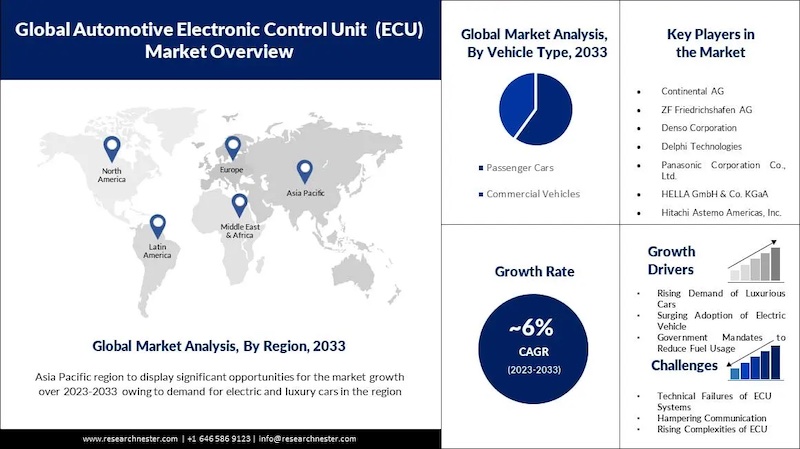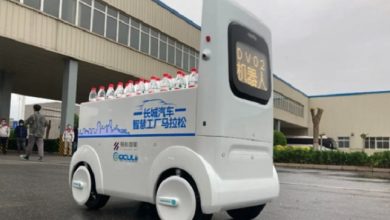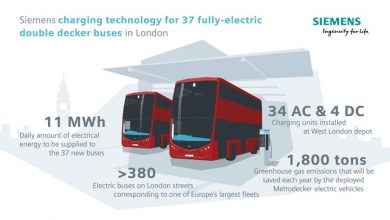Driving innovation: Inside the automotive electronic control unit (ECU) industry

The automotive industry is in a fierce race towards electrification, automation, and connectivity. One component silently enabling this transformation is the Automotive Electronic Control Unit (ECU). ECUs have become the brain behind modern vehicles, managing everything from engine performance to infotainment systems. This rapid evolution in automotive technology has brought exciting growth opportunities to the ECU industry. Let’s us see how ECU revolutionizes the automotive sector.
Performance Demand: The Core of ECU Innovation
The demand for higher-performance ECUs has increased as vehicles become more intelligent. Over 31 million automobiles on the road today are automated to some degree. Today’s vehicles require hundreds of ECUs to coordinate and control various systems. Each system-from advanced driver assistance system-from advanced driver assistance systems (ADAS) to powertrain control-demands enhanced computing power and data management. ECUs that handle multiple systems with low latency are critical for achieving real-time processing for features like autonomous driving.
Companies in the ECU market, particularly in regions like Japan and Europe, are investing heavily in improving computational power while optimizing energy efficiency. Players like Denso and Bosch are constantly pushing boundaries, experimenting with miniaturized ECUs that deliver high computing power without taxing the vehicle energy consumption.
Customization to OEM Requirements
One of the unique aspects of the ECU industry is the highly customized nature of its products. Original Equipment Manufacturers(OEMS) in the automotive industry often require tailor-made ECUs that fit the specific architecture of their vehicles. Japanese automakers like Toyota and Nissan often collaborate closely with their domestic ECUs with their hybrid and electric vehicles. This customization adds complexity to the supply chain, but it also creates a competitive moat for companies that can provide bespoke solutions.
Integration with E/E Architecture: A Major Shift
A fundamental shift is taking place in the automotive industry’s electrical/electronic (E/E) architecture, moving from domain-based ECUs towards centralized architectures. This change will significantly alter how ECUs are designed, with fewer units required to manage more functions. Companies like Continental and ZF are leading the charge in developing centralized computing platforms capable of handling the diverse needs of modern vehicles while reducing the number of individual ECUs.
Centralized systems offer advantages like simplified wiring, reduced weight, and greater scalability for software updates, but they also increase the complexity of ECU software a focal point for automotive innovation.
Automotive Electric Control Units are pivotal in the function of everything from safety systems to infotainment. Let’s break down how these little tech powerhouses are applied across the automotive industry.
Its key application is in powertrain control, optimizing fuel injection, ignition, and emissions for better efficiency. In electric vehicles (EVs), ECUs regulate battery management, maximizing range and monitoring the health of battery systems.
In Advanced Driver Assistance Systems(ADAS), ECUs enable features like lane-keeping assist, adaptive cruise control, and autonomous driving by processing real-time data from sensors and cameras. In the US, 92.7% of new cars are equipped with at least one ADAS.
Infotainment systems also rely on ECUs to manage touchscreens, connectivity, and multimedia controls, ensuring seamless integration with smartphones and external networks.
ECUs control chassis and suspension systems, improving stability and handling through adaptive steering and braking. They also power essential safety features like airbags, anti-lock braking systems(ABS), and electronic stability control(ESC), acting swiftly in emergency situations.
Additionally, ECUs manage climate control, lighting systems, and vehicle security, ensuring a comfortable and safe ride. As vehicles become increasingly connected, ECUs handle telematics, supporting vehicle-to-vehicle(V2V) communication, remote diagnostics, and cybersecurity. Research Nester Analysts estimate that 95% of newly marketed automobiles will be networked by 2030. ECUs are the driving force behind the evolving technology in the automotive world.
Industrial Landscape
The Automotive Electronics Control Unit (ECU) industry is highly competitive, driven by advancements in electric vehicles (EVs), autonomous driving, and connectivity. According to forecasts, the size of the automotive electronic control unit market was estimated to be worth USD 78.22 billion in 2023 and is expected to grow at a compound annual growth rate (CAGR) of approximately 5.7% between 2024 and 2036, when it is expected to reach USD 160.8 billion.
Major players like Bosch, Denso, Continental, and ZF dominate the market with cutting-edge ECU technologies, while newer entrants focus on software innovations and cybersecurity. Over the past ten years, energy densities have increased up to twofold and are predicted to continue to rise. The rise of electric powertrains, semiconductor shortages, and the shift toward centralized E/E architectures are shaping the industry, pushing manufacturers to innovate rapidly to meet OEM demands for smarter, more efficient vehicles.
Regional Overview
The Automotive Electronics Control Unit (ECU) industry Varies significantly by region. Asia Pacific, led by Japan, China, and South Korea, dominates the market due to the strong presence of key automotive manufacturers and suppliers like Denso and Hitachi. For instance, with sales of almost 5 trillion Japanese yen, Denso Corporation ranked as the top producer of auto parts in Japan in 2021.
Europe, driven by countries like Germany and France, is a hub for advanced ECU technologies, especially in electric vehicles and ADAS, with players like Bosch and Continental. With 21.6% of new automobile registrations in the EU being electric, significant progress has been made in the adoption of electric cars and vans. registering about two million electric vehicles in a single year, an increase from 1,74 million in 2021.
North America, with companies like Delphi and Visteon, focuses on innovations in autonomous driving and connectivity. Emerging market in India and Brazil are rapidly growing due to increasing vehicle production and technological adoption. In 2022, almost 14 million automobiles were manufactured in North America.
Ultimately, the Automotive ECUs market is shaping up to be one of the most exciting areas in the auto industry. From the rise of electric vehicles to advances in cybersecurity and AI, ECUs are becoming way more than just controllers. They’re evolving into the nerve centers of modern vehicles, and the companies that adapt to these trends will be the ones driving the future.
https://www.researchnester.com/reports/automotive-electronic-control-unit-market/3982





